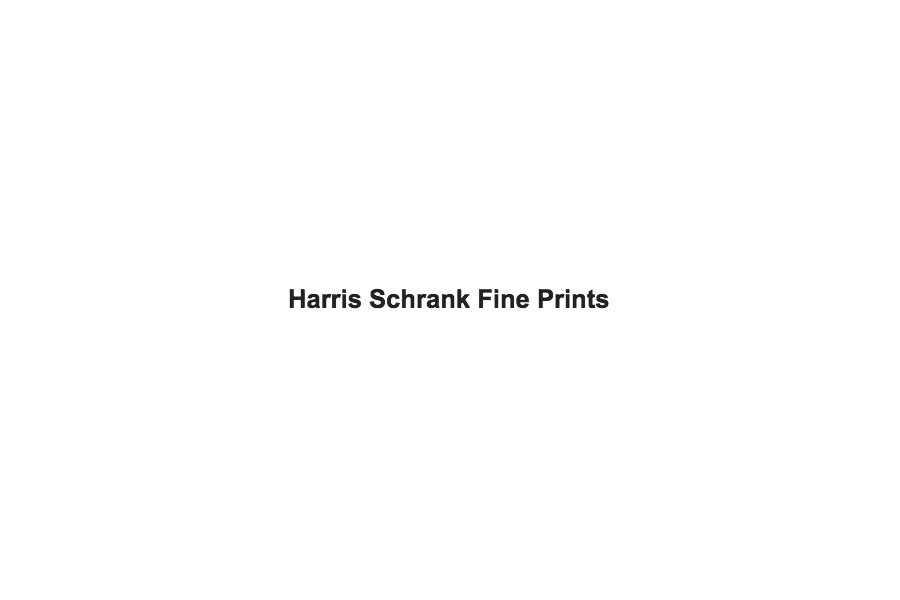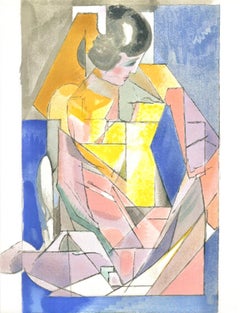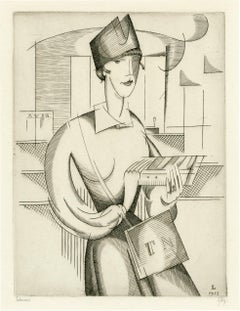Items Similar to La Fille aux Oies
Want more images or videos?
Request additional images or videos from the seller
1 of 2
Jean-Emile LaboureurLa Fille aux Oies1916
1916
$3,000
£2,290.74
€2,608.09
CA$4,212.47
A$4,605.06
CHF 2,436.28
MX$55,106.92
NOK 30,998.20
SEK 28,375.72
DKK 19,480.84
About the Item
Jean-Emile Laboureur (1877-1943), La Fille aux Oies, engraving, 1916, signed in pencil lower left, numbered (4/40) lower right and inscribed “imp,” also titled lower left margin edge. Reference: Sylvan Laboureur 159, second state (of 2), from the edition of 40.In very good condition, with margins (remains of prior hinging verso), 6 3/4 x 6 1/8, the sheet 11 x 8 3/4 inches.
A fine impression of this early cubist-influenced engraving.
In 1917 Apollinaire wrote to Laboureur: “Je voudrais bien avoir le portrait de femme [L. 170] et la gardienne d’oies promis.”
- Creator:Jean-Emile Laboureur (1877-1943, French)
- Creation Year:1916
- Medium:
- Movement & Style:
- Period:
- Condition:
- Gallery Location:New York, NY
- Reference Number:1stDibs: LU51531783803
Jean-Emile Laboureur
Jean Émile Laboureur, born in Nantes on 16 August 1877 and died in Kerfalher in Morbihan on 16 June 1943, was a French painter, draughtsman, engraver, aquafortist, lithographer and illustrator. Author of numerous engravings with burin, in individual plates or for books, he illustrated nearly eighty books, often by contemporary authors such as André Maurois, Jean Giraudoux, Colette, André Gide, Paul-Jean Toulet, Maurice Maeterlinck or François Mauriac. A painter of genre paintings, landscapes, animated or not, still lifes, he also created some frescoes and sculptures. His works are kept in several national and provincial museums. He founded or chaired associations of independent artists.

About the Seller
4.9
Recognized Seller
These prestigious sellers are industry leaders and represent the highest echelon for item quality and design.
Established in 2000
1stDibs seller since 2016
108 sales on 1stDibs
Typical response time: 18 hours
Associations
International Fine Print Dealers Association
- ShippingRetrieving quote...Shipping from: New York, NY
- Return Policy
More From This Seller
View AllLa Fille au Litre (Grande Planche)
By Jean-Emile Laboureur
Located in New York, NY
ean-Emile Laboureur (1877-1943), La Fille au Litre (Grande Planche), engraving, 1921, signed in pencil lower left and inscribed “ep d’art”. Reference: Sylvain Laboureur 217, third st...
Category
1920s Cubist Portrait Prints
Materials
Engraving
La Receveuse
By Jean-Emile Laboureur
Located in New York, NY
Jean-Emile Laboureur (1877-1943), La Receveuse, engraving, 1919-1920, signed in pencil lower left, numbered (2/38) lower right and annotated ”imp” [also with initials and the date 19...
Category
1910s Cubist Portrait Prints
Materials
Engraving
La Marchande de Violettes
By Jean-Emile Laboureur
Located in New York, NY
Jean-Emile Laboureur (1877-1943), La Marchande de Violettes, etching, 1914, signed in pencil lower left and numbered (33/35) lower right [also signed and dated in the plate lower rig...
Category
1910s Cubist Figurative Prints
Materials
Etching
Price Upon Request
Jeune Fille au Chapeau Blanc
By Jean-Emile Laboureur
Located in New York, NY
Jean-Emile Laboureur (1877-1943), Jeune Fille au Chapeau Blanc, 1921, etching and engraving. Reference: S. Laboureur 223, third state (of 3), edition of 30, about 47 impressions pull...
Category
1920s Cubist Portrait Prints
Materials
Engraving, Etching
L'ile Desert
By Jean-Emile Laboureur
Located in New York, NY
Jean-Emile Laboureur (1877-1943), L’ile Desert, etching, 1914, signed in pencil lower left and numbered lower right (33/35). Reference: Laboureur 135, only state, from the edition of...
Category
1910s Cubist Figurative Prints
Materials
Etching
Le Facteur Rural
By Jean-Emile Laboureur
Located in New York, NY
Jean-Emile Laboureur (1877-1943), Le Facteur Rural, engraving, 1924, signed in pencil lower right. Reference: Laboureur 283, third state (of 3), from the total printing of about 80. ...
Category
1920s Cubist Figurative Prints
Materials
Engraving
You May Also Like
Hippolyte : Woman in a Cubist Landscape - Stone lithograph, 1930
By Raymonde Heudebert
Located in Paris, IDF
Raymonde HEUDEBERT
Hippolyte : Woman in a Cubist Landscape, 1930
Original stone lithograph
Printed signature in the plate
On Arches vellum 28 x 22 cm (c. 11 x 9 inch)
Excellent con...
Category
1930s Cubist Figurative Prints
Materials
Lithograph
Jacques Villon, Portrait of a Young Girl, 1973 (after)
By Jacques Villon
Located in Southampton, NY
This exquisite lithograph after Jacques Villon (1875–1963), titled Portrait d'une jeune fille (Portrait of a Young Girl), originates from the 1972 edition published by Editions A. C....
Category
1970s Cubist Abstract Prints
Materials
Lithograph
Cubist Female Nude Woman
Located in Wilton Manors, FL
Joseph Kardonne (1911-1985). Nude Woman, 1946. Watercolor on paper, sheet measures 9 x 6; 13 x 10 inches in matting. Signed, dated and titled lower right. Excellent condition.
Born...
Category
Mid-20th Century Cubist Abstract Paintings
Materials
Watercolor
La Receveuse (Bill Collector) —French Cubism
By Jean-Emile Laboureur
Located in Myrtle Beach, SC
Jean-Emile Laboureur, 'La Receveuse', engraving, 1919, edition 8, first state of two (artist's proof). Laboureur, Godefroy 190.
Signed and numbered '3/8 ép' in pencil. Initialed and...
Category
1910s Cubist Figurative Prints
Materials
Engraving
Cubist Female Nude Woman
Located in Wilton Manors, FL
Joseph Kardonne (1911-1985). Nude Woman, 1968, 10 x 14 inches. Watercolor on paper, sheet measures inches. Signed, dated and titled lower right. Excellent condition.
Born in Newar...
Category
Mid-20th Century Cubist Abstract Paintings
Materials
Watercolor
Cubist Female Woman
Located in Wilton Manors, FL
Joseph Kardonne (1911-1985). Nude Woman, 1966. Watercolor on paper, sheet measures 10 x 13.5 inches. Signed, dated and titled lower right. Excellent condition.
Born in Newark, New ...
Category
Mid-20th Century Cubist Abstract Paintings
Materials
Ink, Watercolor
More Ways To Browse
Kim Jong Un
Klimt Embrace
L Jambor
Last Supper Lithograph
Le Joueur De Flute
Lech Poster
Leonda Finke
Leonor Fini Sphinx
Leroy Neiman Artist Proof
Leroy Neiman Cafe
Leroy Neiman Football
Leroy Neiman Frank Sinatra Prints
Leroy Neiman Frank Sinatra
Leroy Neiman Sailing
Lichtenstein Art Critic
Linogravure Picasso
Luis Salazar
M Utrillo


